University of Szeged
| Szegedi Tudományegyetem | |
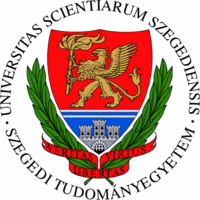 | |
| Motto |
Veritas – Virtus – Libertas Truth – Bravery – Freedom and/or Where knowledge and challenge meet |
|---|---|
| Type | Public |
| Established | 1581/1872/1921 |
| Rector | Prof. Dr. Gábor Szabó |
Administrative staff | 6,600 |
| Students | 30,526 |
| Location | Szeged, Hungary |
| Website | www.u-szeged.hu |
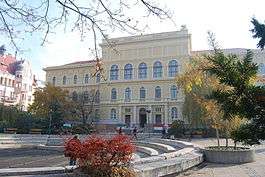
The University of Szeged (Hungarian: Szegedi Tudományegyetem, ![]() listen ) is a large research university in Hungary. It is located in Hungary's third-largest city, Szeged, in Csongrád County in the Southern Great Plain. The University is one of Hungary's most important universities and is among the most prominent higher education institutions in Central Europe. According to the Academic Ranking of World Universities by Shanghai Jiao Tong University (2003, 2004, 2005), it was ranked 203rd–300th in the complete list (in a tie), 80th–123rd in the scientific ranking of European universities, and first in the Hungarian national ranking. In 2013 it was ranked 401-500 in the world, 124th–168th in the scientific ranking of European universities, and second in the national ranking.[1] In 2014, the QS World University Rankings put the University of Szeged as 501-550 among universities globally. Its highest ranked area was Modern Languages with 101-150 globally.[2] The University's operating budget for 2014 was US$220 million.[3]
listen ) is a large research university in Hungary. It is located in Hungary's third-largest city, Szeged, in Csongrád County in the Southern Great Plain. The University is one of Hungary's most important universities and is among the most prominent higher education institutions in Central Europe. According to the Academic Ranking of World Universities by Shanghai Jiao Tong University (2003, 2004, 2005), it was ranked 203rd–300th in the complete list (in a tie), 80th–123rd in the scientific ranking of European universities, and first in the Hungarian national ranking. In 2013 it was ranked 401-500 in the world, 124th–168th in the scientific ranking of European universities, and second in the national ranking.[1] In 2014, the QS World University Rankings put the University of Szeged as 501-550 among universities globally. Its highest ranked area was Modern Languages with 101-150 globally.[2] The University's operating budget for 2014 was US$220 million.[3]
History

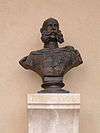
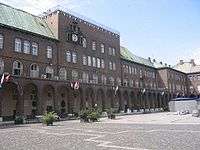
The predecessor to the modern university was the University of Kolozsvár (University of today's Cluj-Napoca), founded in 1872 by Emperor Franz Joseph I., which had to move to Hungary after the Treaty of Trianon in 1921, and was restarted in Szeged.[4]
Among its teachers were Albert Szent-Györgyi, one of the founders of the Faculty of Science, who received the Nobel Prize in Physiology or Medicine in 1937 for his discoveries in connection with Vitamin C.
History of university education in Szeged
After the Great Flood of 1879, the citizens of Szeged made several attempts at establishing an institution of higher education in Szeged. These efforts did not bear fruit until 1921, when the University of Kolozsvár was moved to Szeged. This move was occasioned by the conclusion of World War I, when the Trianon Peace Treaty ceded the province of Transylvania to Romania.
Teaching at the University started on 10 October 1921. The town made considerable efforts to ensure suitable conditions for the new university. The new buildings constructed on the Szeged bank of the Tisza river between 1924 and 1930 housed first of all the clinics and the institutes of the Medical School. Other attractive buildings surrounding the new Cathedral were given to the Faculty of Sciences and to the College of Catholic Theology. The Faculties of Law and Arts were accommodated in older buildings, originally used for other purposes.
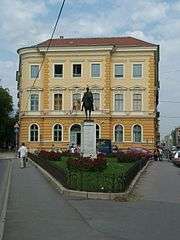
Many outstanding professors worked at the university in the inter-war period, including Nobel Prize winner Albert Szent-Györgyi, who was the first to isolate Vitamin C, extracting it from paprika. Publications under the collective title of "Acta Universitatis Szegediensis", edited at different faculties and institutes, were already winning fame for the University at that time; the Society of the Friends of the University helped towards their publication. The Medical School (now incorporated into the University of Szeged) was given the name Szent-Györgyi.
In 1940, during World War II, the József Ferenc University was moved back to Kolozsvár, while in Szeged, a new university was legally established, mainly employing former staff and using the same buildings. Fascist laws issued during the war had a very adverse effect on both the personnel and the financial management of the University; the institution was in a very serious situation when Soviet troops entered Szeged on 11 October 1944.
After World War II, the University of Szeged was the first in Hungary to start functioning anew. Teaching began as early as 3 November 1945. In those years Rector Frigyes Riesz, a prominent mathematician, and his staff distinguished themselves in creating reliable conditions for the work of higher education.

In 1951, the Medical School was separated from the university and was established as an independent institution. In 1962 the University of Szeged assumed the name of the great Hungarian poet, Attila József, who was a student here in the 1920s. During the post-war period the University has undergone a tremendous development. Since the Medical School was separated, the departments of the remaining faculties grew from 36 to 82 by 1990. The number of students is about five times greater than those 774 who matriculated in 1945–46. A similar proportion applies to the teaching professorial staff. The number of academic staff at the University now totals 530. SZTE plays an important role in Hungarian scholarly life and our University is not only a well-reputed school but in general qualifies as a research university and in several fields prides itself as being an important international research center, too. Nine of their professors are members of the Hungarian Academy of Sciences.
The number of the university buildings and the area they cover have also grown considerably. As has been indicated, the University of Szeged has never had a unified campus, its buildings were rather scattered in the downtown area. As the university has grown, its buildings started characterizing more and more districts of Szeged. Remarkable among the new, modern establishments is the "Peace Building", inaugurated in 1952, which was built as a harmonious addition to the red brick buildings of the Faculty of Science.

The Bolyai Institute of Mathematics occupied the former High School of the Piarist Order in 1951, right in the neighborhood of the other science departments. The completion of one wing of a planned triangular building in New Szeged – the Biology Center – further enlarged the space for natural sciences in 1974. Two years later a teacher training primary school was opened and the University's Computer Center could move into the modernized former prep school building right in the city center, halfway between the Rector's office and the Faculty of Sciences. The Faculty of Arts could grow as some natural science departments abandoned the Arts Building in Ady square; further considerable extension was provided by acquiring an office building next to the Arts Building where the departments of education, psychology, philosophy, economics and sociology found accommodation in 1978.
The Faculty of Law also gained space as in 1963–64 a new level was added to their old building. The infrastructure of the University and student life was facilitated by the construction of two large dormitories and an adjacent cafeteria in New Szeged (1966–1977). In 1986 the University purchased a large workers' hostel and turned it into a comfortable dormitory with which currently the dormitory places available amount to 950.

The 1980s did not bring major developments. The downturn of the economic situation demanded tight budgets and – by the end of the decade – the University severely needed further physical upgrade. The turning of the decade fortunately has brought major changes. In 1989, with the changing of the political system in Hungary, the extensive infrastructure of the former Hungarian Socialist Workers' Party was redistributed and the buildings became utilized mostly for educational and medical purposes. As a result of these changes, in 1990, JATE could occupy the county headquarters of that party, a lavish seven-storey building; which now houses the Financing Office and parts of the Faculty of Law. Another important project, the renovation of the Irinyi Building next to the Faculty of Sciences, was completed in 1992. The renovated Irinyi Building now accommodates the bulk of the most needed new classrooms and lecture halls, serving all three faculties. This building is the university's center of catering: three cafeterias and a restaurant offer food to students and faculty.
The majestic central building of the University in Dugonics square was also restructured. With the removal of the Financing Office, the University Library (Városi Somogyi Könyvtár – Bibliotheca Civitatis Szegedinensis de Carolo Somogyi nominata) can grow by almost one-third of its original space, and also the rectors of both universities will have more comfortable offices. The central building houses the Faculty Club and the Students' Club, too. Further university facilities are the general sports ground and gymnasium in the square behind the Arts Building, a high quality tennis center in the park in New Szeged, a picturesque lodge and conference hall (once a country school now modernized) in the woods, 30 km from Szeged, and a resort house at Lake Balaton.

Timeline
| Year | event |
|---|---|
| 1872 | Foundation of the University of Kolozsvár |
| 1921 | The "Franz Joseph" University moved to Szeged |
| 1951 | The Medical School was separated from the University and was established as an independent institution |
| 1962 | The University assumed the name of "Attila József" (JATE) |
| 2000 | Unification of institutions as the University of Szeged (SZTE) |
Name of the university (in Hungarian)
| Name | place | time | |
|---|---|---|---|
| 1 | Kolozsvári Tudományegyetem | Kolozsvár | (1872–1881) |
| 2 | Ferenc József Tudományegyetem | Kolozsvár | (1881–1919) |
| 3 | Ferenc József Tudományegyetem | Budapest | (1919–1921) |
| 4 | Ferenc József Tudományegyetem | Szeged | (1921–1940) |
| 5 | Ferenc József Tudományegyetem | Kolozsvár | (1940–1945) |
| 6 | Szegedi Tudományegyetem | Szeged | (1945–1962) |
| 7 | József Attila Tudományegyetem | Szeged | (1962–1999) |
| 8 | Szegedi Tudományegyetem | Szeged | (2000– ) |
Setting and architecture
Cathedral Square

Cathedral (Hungarian: Dóm) Square is one of the largest public spaces in Hungary, with a total area of 12,000 m² (similar to that of Venice's Saint Mark's Square). In 1920, all the buildings in the vicinity were torn down, giving way to the modern square, which was built according to the designs of the architect Béla Rerrich. The square is surrounded in a U-shape by archwayed buildings made of dark brown bricks. The buildings are shared by Szeged University, the College of Catholic Theology, the Seat of the Bishop and a university dormitory. The reliefs decorating the walls were made by Béla Ohmann. After the noon chimes, a musical clock (the work of Ferenc Csuri, a master watchmaker) brings models of famous University figures to life. 86 statues of prominent Szeged University figures line the walls of the archways.
Dugonics Square

The main building of the University, built between 1872 and 1873 to the designs of Antal Skalnitzky and Ferenc Arleth, was moved to Dugonics Square in 1921. Before the Great Szeged Flood of 1879, the square was home to Szeged's wheat market. A fountain, built in 1979 on the 100th anniversary of the flood by István Tarnai, occupies the centre of the square. Also present is a statue commemorating the famous Hungarian poet Attila József, which was sculpted by Imre Varga in 1964. Festivals and concerts are often held in Dugonics Square, which is a popular hangout for students of the University.
Organisation
- Related article: Albert Szent-Györgyi Medical University
Szeged University has 11 primary faculties:
- Faculty of Agriculture – MGK
- Faculty of Health Sciences – ETSZK
- Faculty of Food Engineering – MK
- Faculty of Arts – BTK
- Faculty of Economics and Business Administration – GTK
- Faculty of Law and Public Administration – ÁJTK
- Faculty of Medicine – ÁOK
- Faculty of Music (Conservatory) – ZMK
- Faculty of Pharmacy – GYTK
- Faculty of Sciences and Informatics – TTIK
- Gyula Juhász Faculty of Education JGYPK
Departments and faculties
The once independent Albert Szent-Györgyi Medical University is now a faculty in the University of Szeged. The Faculty of Medicine, Dentistry and pharmacy is part of the Albert Szent-Györgyi Medical and Pharmaceutical Center of Szeged university. These programs leads to the Doctor of Medicine, Doctor of dental surgery and Doctor of Pharmacy degree, which consist of six years, five years and five years programs respectively. The medical program of the university is recognized by the WHO & Medical Board of California and it is accepted without any licensing examinations in all European Union countries (applies to the nationals of the member states.)
The international programs in Medicine started in 1984 in English. in 1999 a German-language program was also introduced. In the past one and a half decades more than thousand international students were enrolled coming from 50 countries around the world. The applicants to the program must pass a written and oral examination in Biology, Chemistry and English. Entrance exams are arranged at several locations in Europe, Israel, North America, Asia and Africa.
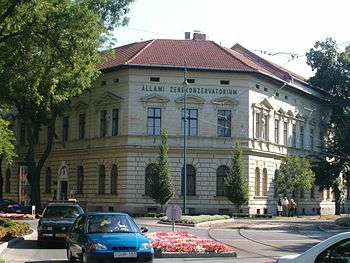
- Faculty of Medicine
- Faculty of Dentistry
- Faculty of Pharmacy
- Faculty of Law
- Faculty of Economics and Business Administration
- Faculty of Engineering
- Faculty of Health Sciences and Social Studies
- Faculty of Arts
- Faculty of Music
- Faculty of Science and Informatics
- Faculty of Agriculture
- Faculty of Education
- Research Institute: János Bolyai Mathematical Institute
Recent developments
The university's future has been determined by a few cardinal decisions in recent years. The leaders of the institutions of higher education in Szeged (JATE, Albert Szent-Györgyi Medical University, Gyula Juhász Teacher Training College, Ferenc Liszt College of Music, College of Catholic Theology, and the College of Food Technology and Engineering) have signed an agreement to merge these institutions into a unified, sizable center of higher education, to be called the University of Szeged. As of today the "in the past independent" universities made up the faculties of the University of Szeged. The unification of these institutions was finished in January 2000. Now the University of Szeged is planning to expand not only its quality of education but its facilities by the help of EU loans. Now the University of Szeged is able to serve the students with a huge scope of educational opportunities. The university's Medical Faculty now teaches in both Hungarian, English and German and is the nation's most prestigious department of medical education.
The new Attila József Study and Information Centre (Hungarian: József Attila Tanulmányi és Információs Központ – JATIK) is located not far from Szeged's city center and houses the university library, computer center and lecture halls. The University plans to build another two new faculties in the coming years.
Enrollment
The university currently has almost 30,000 university students, studying a total of 134 majors. The teaching staff number 1,393, among them 18 academicians, 123 academic doctors and 818 with PhDs.
| Students (2003/2004) in | full-time | evening classes | correspondence study | distance learning | total |
|---|---|---|---|---|---|
| College Faculty of Agriculture – MFK | 339 | – | 364 | 188 | 891 |
| College Faculty of Health Sciences – EFK | 782 | – | 635 | – | 1 417 |
| College of Food Engineering – SZÉF | 801 | – | 841 | – | 1 642 |
| Faculty of Arts – BTK | 3 588 | 44 | 2 416 | – | 6 048 |
| Faculty of Economics and Business Administration – GTK | 731 | 175 | 284 | 508 | 1 698 |
| Faculty of Law and Public Administration – ÁJTK | 1 600 | – | 3 125 | – | 4 725 |
| Faculty of Medicine – ÁOK | 1 523 | – | – | – | 1 523 |
| Faculty of Music (Conservatory) – ZFK | 217 | – | – | – | 217 |
| Faculty of Pharmacy – GYTK | 549 | – | – | – | 549 |
| Faculty of Sciences and Informatics – TTIK | 3 855 | 17 | 479 | – | 4 351 |
| Gyula Juhász Faculty of Education – JGYPK | 2 976 | – | 4 489 | – | 7 465 |
| Enrollment | 16 961 | 236 | 12 633 | 696 | 30 526 |
Foreign students, like at other universities in Hungary, have to pay for tuition, while native Hungarians – under certain conditions – pay no fees.
The Hungarian Government initialized a scholarship aiming at foreign countries to open an opportunity for them to study in Hungary and also at the University of Szeged. This is called the Stipendium Hungaricum Scholarship.[5] The program was launched in 2013 and is still successfully running.
Students can apply from the following partner countries: Algeria, Angola, Argentina, Azerbaijan, Belarus, Bosnia and Herzegovina, Cambodia, China (Hudec scholarship also), Colombia, Ecuador, Egypt, Georgia, India, Iraq, Japan, Jordan, Kazakhstan, Korea, Kurdistan Regional Government/Iraq, Laos, Lebanon, Macedonia, Mexico, Moldova, Mongolia, Morocco, Myanmar, Namibia, Nigeria, Palestine, Tunisia, Turkey, Turkmenistan, Uruguay, Vietnam, Yemen
For more information about the program and the application process, please visit your government's website.
Notable alumni and professors

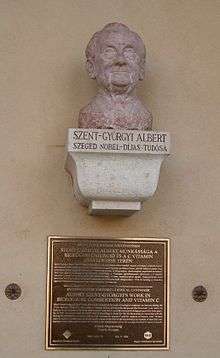
Nobel laureate
Humanities and Social Sciences
Faculty of Arts
- János Csengery, philosophy
- Zoltán Gombocz, philologist
- Sándor Imre, pedagogy
- Károly Marót, philosophy
- Sándor Márki, medieval history
- Ágoston Pável, ethnology
- István Schneller, pedagogy
- Sándor Sik, hungarian literature
- Antal Szerb, author
- József Szinnyei, history of literature
- Hildebrand Dezső Várkonyi psychologist
Faculty of Law and Public Administration
- István Bibó, politics
- László Buza, international law
- Győző Concha, politics
- István Ereky, public administration
- Ferenc Finkey, criminal law
- Barna Horváth, sociology of law
- Sándor Kolosváry, private law
- Ernő Nagy, public law
- Kelemen Óvári, history of law
- Ödön Polner, public law
- Elemér Pólay, Roman law
- Bódog Somló, philosophy of law
Natural Sciences

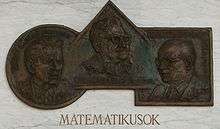

Faculty of Medicine
- József Baló, anatomy
- Gábor Fodor, chemistry
- Endre Hőgyes, pharmacy
- Béla Issekutz senior, pharmacy
- Miklós Jancsó senior, internal medicine
- Dezső Miskolczy, neurology
- István Rusznyák, internal medicine
Faculty of Sciences
- István Apáthy, zoology
- Zoltán Bay, physicist
- Jenő Cholnoky, geography
- Lipót Fejér, mathematics
- István Györffy, botanics
- Alfréd Haar, mathematics
- László Kalmár, computer science
- Béla Kerékjártó, geometry
- László Lovász, mathematics; Wolf Prize 1999, Knuth Prize 1999, Kyoto prize 2010.
- Tibor Radó, mathematics
- László Rédei, mathematics
- Frigyes Riesz, mathematics
- Brúnó F. Straub, biology
- Béla Szőkefalvi-Nagy, mathematics
Notable students
- Peter Heszler, physicist
- Attila József, poet
- Gyula Juhász, poet, journalist, educator
- László Bela Kish, physicist
- Miklós Radnóti, poet
- Mario Szenessy, author
- István Tömörkény, writer, archeologist and journalist
- Mohammad Sharif Chattar, educationist, botanist, author, poet
Olympic athletes
- Natasa Janics, canoeing, gold medal
- Márton Joób, canoeing, gold medal
See also
Lists
Publications
Research
University related places
Faculties and departments
- Szeged, Balaton, Budapest, Hódmezővásárhely, Kecskemét
Historical
References
- ↑ "Shanghai University Rankings". ARWU. Retrieved 30 March 2014.
- ↑ "QS University Rankings". QS. Retrieved 30 March 2014.
- ↑ "Budgetary Data". SZTE. Retrieved 30 March 2014.
- ↑ The history of the University of Szeged
- ↑ "Stipendium Hungaricum - Tempus Közalapítvány". www.tka.hu. Retrieved 2015-10-19.
Bibliography
- János Martonyi, József Ruszoly: A JATE története – A Szegedi Tudományegyetem múltja és jelene. Szeged, 1999.
External links
| Wikimedia Commons has media related to Szeged Education. |
Coordinates: 46°15′00″N 20°08′47″E / 46.2500°N 20.1465°E


